Study on the Roof Solar Heating Storage System of Traditional Residences in Southern Shaanxi, China
Abstract
:1. Introduction
1.1. Motivation
1.2. Literature Studies
1.3. Scientific Originalities
1.4. Aim of the Study
- Measuring the heating time, equilibrium temperature, and heating efficiency of the basic system.
- Calculating the heat storage performance and heating efficiency of the attic slab material.
- Measuring the heating time, equilibrium temperature, and heating efficiency of the new system.
- Evaluating the appropriate times for using the new system for the entire year and calculating the annual heat load reduction and energy-saving effect when using the new system.
2. Methodology
2.1. Current Situation Research
2.1.1. Research Location
2.1.2. Research Method
2.1.3. Research Content
2.1.4. Comparative Analysis of Current Heating Methods
2.2. Roof Solar Heating Storage System
2.2.1. Design of the Roof Solar Heating Storage System
2.2.2. Working Principle of the Roof Solar Heating Storage System
2.2.3. Analysis of Basic Heating
- (1)
- With solar radiation
- (2)
- Without solar radiation
2.2.4. Analysis of the Situation of the Roof Solar Heating Storage System
- (1)
- With solar radiation
- (2)
- Without solar radiation
2.3. Simulation Analysis
3. Results and Discussion
3.1. Comparison between the Basic Heating System and the New System without Solar Heat Radiation
3.1.1. Basic Heating without Solar Heat Radiation
3.1.2. The Roof Solar Heating Storage System without Solar Thermal Radiation
3.1.3. Comparative Analysis
3.2. Comparison between the Basic Heating System and the New System with Solar Heat Radiation
3.2.1. Basic Heating with Solar Heat Radiation
3.2.2. Roof Solar Heating Storage System with Solar Thermal Radiation
3.2.3. Comparative Analysis
3.3. Heating Time with the New System
3.4. Energy-Saving Situation of Using the New System
3.5. Thermal Comfort with the New System
3.6. Empirical Research
4. Conclusions and Outlook
4.1. Conclusions
- Using the thermal storage roof pool solar heating system, the indoor temperature increased by 4.9 °C with solar radiation, and the mean heating efficiency was 0.82 °C/h. The indoor temperature increased by 1.4 °C without solar radiation, and the mean heating efficiency was 0.16 °C/h.
- Using basic heating, the interior temperature increased by 2.5 °C with solar radiation, and the mean heating efficiency was 0.42 °C/h. The indoor temperature increased by 1.1 °C without solar radiation, and the mean heating efficiency was 0.12 °C/h.
- The time spent using the solar heating system was mainly distributed in in January, February, March, November, and December. The solar energy system was used for 807 h all year without solar radiation, accounting for 9.16% of whole year. The time spent using the new system in the whole year was 1141 h with solar heat radiation, accounting for 12.95% of whole year.
- The annual heat load of the new system was reduced by 517.84 kW·h without solar radiation, and the reduction ratio was 9.51%, while it was reduced by 1361.92 kW·h with solar radiation, and the reduction ratio is 25.02%.
- Taking 18 °C as the limit of indoor thermal comfort, we calculated the time when the new system was below 18°C. Under the condition of basic heating, the time when the temperature of the building was lower than 18 °C was 5019 h, accounting for 56.98% of the year. When the solar energy system was adopted, the time when the interior temperature was lower than 18 °C is 4006 h without solar radiation, accounting for 46.36% of the year. The time when the temperature was lower than 18 °C all year was 3763 h with solar radiation, accounting for 43.55% of the year.
4.2. Outlook
- The appropriate value of the roof transparent area ratio and the roof inclination angle can be further explored to obtain more solar radiation indoors and to achieve the best indoor temperature.
- The heat storage plate used HDPE heat storage material. In future research, we should combine the development of science and technology to explore more suitable heat storage materials to further increase the indoor temperature in winter.
Author Contributions
Funding
Institutional Review Board Statement
Informed Consent Statement
Acknowledgments
Conflicts of Interest
References
- International Energy Agency (IEA). IEA Online Data Services. Available online: https://www.iea.org/data-and-statistics/data-browser/?country=WORLD&fuel=Energy%20consumption&indicator=CO2Industry (accessed on 20 February 2021).
- National Bureau of Statistics of China. Statistical Communiqué on China’s 2019 National Economic and Social Development. Available online: https://baike.sogou.com/v185466837.htm?fromTitle (accessed on 10 August 2020).
- Research Report on Building Energy Consumption in China. 2018. Available online: https://www.cabee.org/site/content/22960.html (accessed on 29 December 2018).
- Zhou, F.; Liu, X.; Chen, N. Research on China’s New Energy Development Strategy and New Energy Industry System Construction. Shanghai Acad. Soc. Sci. Press 2016, 12, 372. [Google Scholar]
- Chen, Y. Analysis of energy consumption status and energy saving tasks of rural buildings in my country. Mod. Agric. Sci. Technol. 2011, 22, 275–277. [Google Scholar]
- Hong, Z. Energy Consumption and Energy Conservation Potential Assessment of Clean Renewable Energy in Rural Households in China. Lanzhou Univ. 2020, 323, 214. [Google Scholar]
- Huang, J.; Wang, S.; Teng, F.; Feng, W. Thermal performance optimization of envelope in the energy-saving renovation of existing residential buildings. Energy Build. 2021, 247, 111103. [Google Scholar] [CrossRef]
- Han, J.; Yang, X. Analysis of Passive Energy-saving Retrofitting of Rural Residential Houses in Southern Anhui Province—A case in Hongcun. Energy Procedia 2018, 152, 470–474. [Google Scholar] [CrossRef]
- Castaldo, V.L.; Pisello, A.L.; Piselli, C.; Fabiani, C.; Cotana, F.; Santamouris, M. How outdoor microclimate mitigation affects building thermal-energy performance: A new design-stage method for energy saving in residential near-zero energy settlements in Italy. Renew. Energy 2018, 127, 920–935. [Google Scholar] [CrossRef]
- Krarti, M.; Aldubyan, M. Role of energy efficiency and distributed renewable energy in designing carbon neutral residential buildings and communities: Case study of Saudi Arabia. Energy Build. 2021, 250, 111309. [Google Scholar] [CrossRef]
- Elhashmi, R.; Hallinan, K.P.; Chiasson, A.D. Low-energy opportunity for multi-family residences: A review and simulation-based study of a solar borehole thermal energy storage system. Energy 2020, 204, 117870. [Google Scholar] [CrossRef]
- Neves, R.; Cho, H.; Zhang, J. Techno-economic analysis of geothermal system in residential building in Memphis, Tennessee. J. Build. Eng. 2020, 27, 100993. [Google Scholar] [CrossRef]
- Li, Y.; Nord, N.; Xiao, Q. Building heating applications with phase change material: A comprehensive review. J. Energy Storage 2020, 31, 101634. [Google Scholar] [CrossRef]
- Chi, F.; Wang, R.; Wang, Y. Integration of passive double-heating and double-cooling system into residential buildings (China) for energy saving. Sol. Energy 2021, 225, 1026–1047. [Google Scholar] [CrossRef]
- Chi, F.; Xu, L.; Peng, C. Integration of completely passive cooling and heating systems with daylighting function into courtyard building towards energy saving. Appl. Energy 2020, 266, 102536. [Google Scholar] [CrossRef]
- Wang, H.; Zhang, Y.; Ci, E.; Li, X.; Li, J. An experimental study in full spectra of solar-driven magnesium nitrate hexahydrate/graphene composite phase change materials for solar thermal storage applications. J. Energy Storage 2021, 38, 102536. [Google Scholar] [CrossRef]
- Carlini, M.; Castellucci, S.; Mennuni, A.; Morelli, S. Numerical modeling and simulation of pitched and curved-roof solar greenhouses provided with internal heating systems for different ambient conditions. Energy Rep. 2020, 6, 146–154. [Google Scholar] [CrossRef]
- Paraschiv, S.; Nicoleta, B.-M.; Paraschiv, L.S. Technical and economic analysis of a solar air heating system integration in a residential building wall to increase energy efficiency by solar heat gain and thermal insulation. Energy Rep. 2020, 6, 459–474. [Google Scholar] [CrossRef]
- Liu, Z.; Wu, D.; He, B.-J.; Wang, Q.; Yu, H.; Ma, W. Evaluating potentials of passive solar heating renovation for the energy poverty alleviation of plateau areas in developing countries: A case study in rural Qinghai-Tibet Plateau, China. Sol. Energy 2019, 187, 95–107. [Google Scholar] [CrossRef]
- Daniele, F.; Bertolli, A. Design and exergy analysis of solar roofs: A viable solution with esthetic appeal to collect solar heat. Renew. Energy 2012, 46, 60–71. [Google Scholar]
- Mohammed, D.-E.; Smaili, A.; Fellouah, H.; Merabtine, A. Experimental and numerical investigations of a solar space heating system based on design of experiments method. Sol. Energy 2021, 216, 396–410. [Google Scholar]
- Mohammad, A.; Tao, Z.; Abden, M.; Rahman, A.; Samali, B. Improving performance of solar roof tiles by incorporating phase change material. Sol. Energy 2020, 207, 1308–1320. [Google Scholar]
- Simões, N.; Manaia, M.; Simões, I. Energy performance of solar and Trombe walls in Mediterranean climates. Energy 2021, 234, 121197. [Google Scholar] [CrossRef]
- Guo, J.; Dong, J.; Zou, B.; Wang, H.; Zhu, L.; Jiang, Y. Experimental investigation on the effects of phase change material and different ventilation modes on the thermal storage, space heating and energy consumption characteristics of ventilated mortar blocks. J. Energy Storage 2021, 41, 102817. [Google Scholar] [CrossRef]
- Cossu, M.; Yano, A.; Li, Z.; Onoe, M.; Nakamura, H.; Matsumoto, T.; Nakata, J. Advances on the semi-transparent modules based on micro solar cells: First integration in a greenhouse system. Appl. Energy 2016, 162, 1042–1051. [Google Scholar] [CrossRef] [Green Version]
- Sá, A.; Martins, A.; Cunha, J.B.; Lanzinha, J.C. Energy performance of Trombe walls: Adaptation of ISO 13790:2008(E) to the Portuguese reality. Energy Build. 2014, 74, 111–119. [Google Scholar]
- Irshad, K.; Habib, K.; Nagarajan, T. Energy and Cost Analysis of Photo Voltaic Trombe Wall System in Tropical Climate. Energy Procedia 2014, 50, 71–78. [Google Scholar] [CrossRef] [Green Version]
- Shen, J.; Lassue, S.; Zalewski, L.; Huang, D. Numerical study on thermal behavior of classical or composite Trombe solar walls. Energy Procedia 2007, 39, 962–974. [Google Scholar] [CrossRef]
- Duan, S.; Li, H.; Zhao, Z.; Wang, L. Investigation on heating performance of an integrated phase change material Trombe wall based on state space method. J. Energy Storage 2021, 38, 102460. [Google Scholar] [CrossRef]
- Rabani, M.; Kalantar, V.; Dehghan, A.A.; Faghih, A.K. Experimental study of the heating performance of a Trombe wall with a new design. Sol. Energy 2015, 118, 359–374. [Google Scholar] [CrossRef]
- Hussain, H.; Kayiem, A. Experimental and numerical analysis of the influence of inlet configuration on the performance of a roof top solar chimney. Energy Build. 2018, 159, 89–98. [Google Scholar]
- Wi, S.; Park, J.; Kim, Y.; Yang, S. Thermal, hygric, and environmental performance evaluation of thermal insulation materials for their sustainable utilization in buildings. Environ. Pollut. 2021, 272, 116033. [Google Scholar] [CrossRef]
- Chavan, S.; Gumtapure, V. Numerical and experimental analysis on thermal energy storage of polyethylene/functionalized graphene composite phase change materials. J. Energy Storage 2020, 27, 101045. [Google Scholar] [CrossRef]
- Mohammed, M.F.; Amar, M.K.; Siddique, A.K.R.; Said, A. A review on phase change energy storage: Materials and applications. Energy Convers. Manag. 2004, 45, 1597–1615. [Google Scholar]
- Song, J.; Zeng, L.K.; Ren, X.T.; Shui, A.Z.; Liu, Y.Z.; Wang, H. Research status and Prospect of heat storage materials. Eng. Technol. 2007, 1, 5–10. [Google Scholar]
- Xian, W.C.; Chun, N.L.; Guang, J.H.; Yi, Z.T.; Zhi, T.Y. Composite phase change materials of ultra-high molecular weight polyethylene/paraffin wax/carbon nanotubes with high performance and excellent shape stability for energy storage. J. Energy Storage 2021, 44, 103460. [Google Scholar]
- Lal, S.; Kaushik, S.C.; Bhargav, P.K. Solar chimney: A sustainable approach for ventilation and building space conditioning. Int. J. Dev. Sustain. 2013, 2, 1–21. [Google Scholar]
- Piyachai, K.A.N.J.L.; Drew, L.; Chen, H.Z.; Sumanjeet, K.; Ravi, P.; Gao, L. Random copolymer of poly(polyethylene glycol methyl ether)methacrylate as tunable transition temperature solid–solid phase change material for thermal energy storage. Sol. Energy Mater. Sol. Cells 2021, 225, 111030. [Google Scholar]
- Li, Y.; Liu, S. Experimental study on thermal performance of a solar chimney combined with PCM. Appl. Energy 2014, 114, 172–178. [Google Scholar] [CrossRef]
- Gan, G. A parametric study of Trombe walls for passive cooling of buildings. Energy Build. 1998, 27, 37–43. [Google Scholar] [CrossRef]
- Shi, L. Theoretical models for wall solar chimney under cooling and heating modes considering room configuration. Energy 2018, 165, 925–938. [Google Scholar] [CrossRef]
- Haghighi, A.P.; Maerefat, M. Solar ventilation and heating of buildings in sunny winter days using solar chimney. Sustain. Cities Soc. 2014, 10, 72–79. [Google Scholar] [CrossRef]
- Jing, H.; Chen, Z. Experimental study of the prediction of the ventilation flow rate through solar chimney with large gap-to-height ratios. Build. Environ. 2015, 89, 150–159. [Google Scholar] [CrossRef]
- Rashidi, S.; Esfahani, J.A.; Hosseinirad, E. Assessment of solar chimney combined with phase change materials. J. Taiwan Inst. Chem. Eng. 2021, 124, 341–350. [Google Scholar] [CrossRef]
- Miyazaki, T.; Akisawa, A.; Kashiwagi, T. The effects of solar chimneys on thermal load mitigation of office buildings under the Japanese climate. Renew. Energy 2006, 31, 987–1010. [Google Scholar] [CrossRef]
- Monteiro, H.; Freire, F.; Soares, N. Life cycle assessment of a south European house addressing building design options for orientation, window sizing and building shape. J. Build. Eng. 2021, 39, 102276. [Google Scholar] [CrossRef]
- Xue, P.; Li, Q.; Xie, J.; Zhao, M.; Liu, J. Optimization of window-to-wall ratio with sunshades in China low latitude region considering daylighting and energy saving requirements. Appl. Energy 2019, 233, 62–70. [Google Scholar] [CrossRef]
- Feng, G.; Chi, D.; Xu, X.; Dou, B.; Sun, Y.; Fu, Y. Study on the Influence of Window-wall Ratio on the Energy Consumption of Nearly Zero Energy Buildings. Procedia Eng. 2017, 205, 730–737. [Google Scholar] [CrossRef]
- Attia, S.; Gratia, E.; Herde, A.D.; Jan, L.M. Simulation-based decision support tool for early stages of zero-energy building design. Energy Build. 2012, 49, 2–15. [Google Scholar] [CrossRef] [Green Version]
- Marino, C.; Nucara, A.; Pietrafesa, M. Does window-to-wall ratio have a significant effect on the energy consumption of buildings? A parametric analysis in Italian climate conditions. J. Build. Eng. 2017, 13, 169–183. [Google Scholar] [CrossRef]
- Alghoul, S.K.; Rijabo, H.G.; Mash, M.E. Energy consumption in buildings: A correlation for the influence of window to wall ratio and window orientation in Tripoli, Libya. J. Build. Eng. 2017, 11, 82–86. [Google Scholar] [CrossRef]
- Obrecht, T.P.; Premrov, M.; Leskovar, V. Influence of the orientation on the optimal glazing size for passive houses in different European climates (for non-cardinal directions). Sol. Energy 2019, 189, 15–25. [Google Scholar] [CrossRef]
- Ashrafian, T.; Moazzen, N. The impact of glazing ratio and window configuration on occupants’ comfort and energy demand: The case study of a school building in Eskisehir, Turkey. Sustain. Cities Soc. 2019, 47, 101483. [Google Scholar] [CrossRef]
- Goia, F.; Haase, M.; Perino, M. Optimizing the configuration of a façade module for office buildings by means of integrated thermal and lighting simulations in a total energy perspective. Appl. Energy 2013, 108, 515–527. [Google Scholar] [CrossRef] [Green Version]
- Goia, F. Search for the optimal window-to-wall ratio in office buildings in different European climates and the implications on total energy saving potential. Sol. Energy 2016, 132, 467–492. [Google Scholar] [CrossRef]
- Wen, L.; Hiyama, K.; Koganei, M. A method for creating maps of recommended window-to-wall ratios to assign appropriate default values in design performance modeling: A case study of a typical office building in Japan. Energy Build. 2017, 145, 304–317. [Google Scholar] [CrossRef]
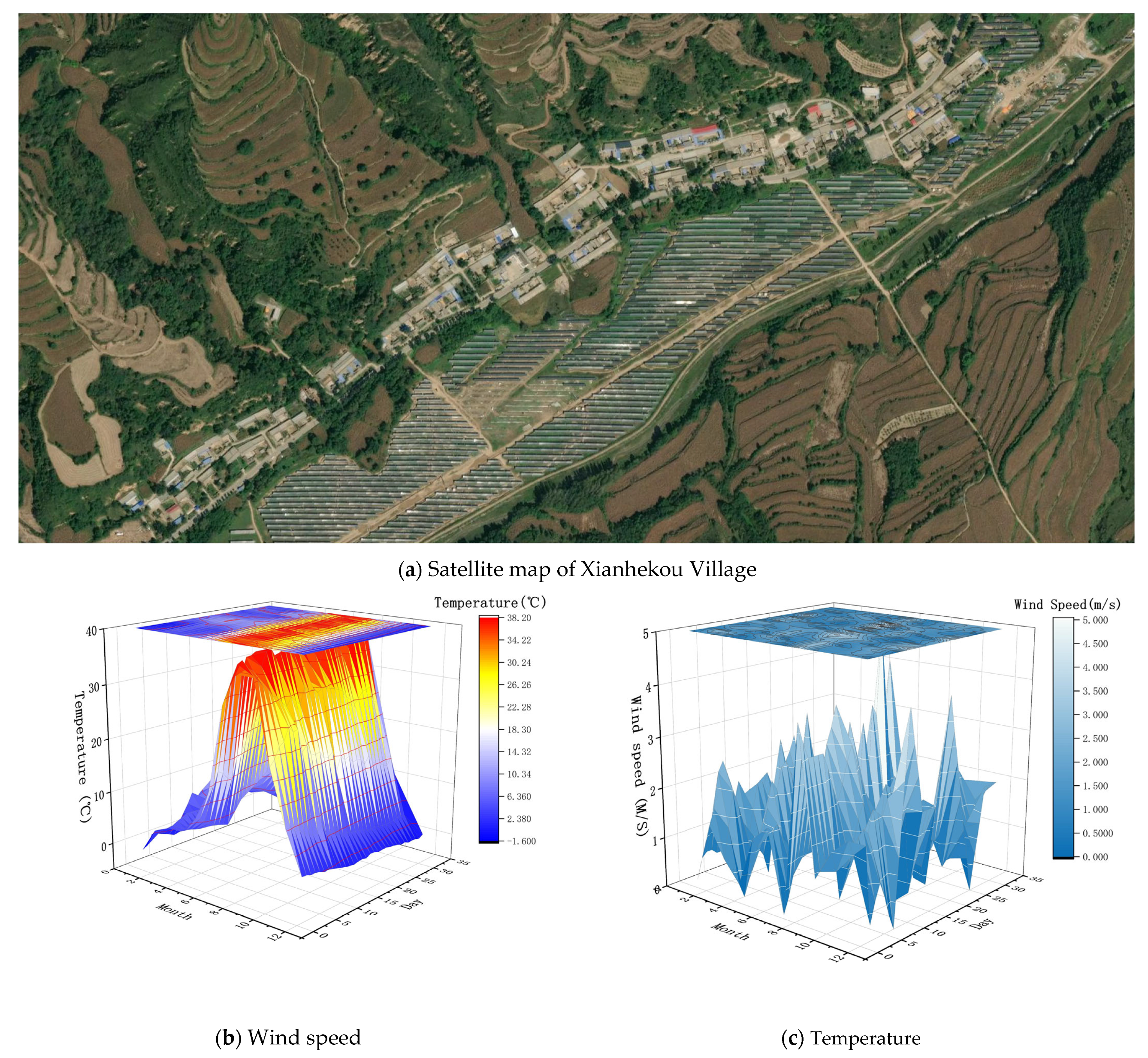
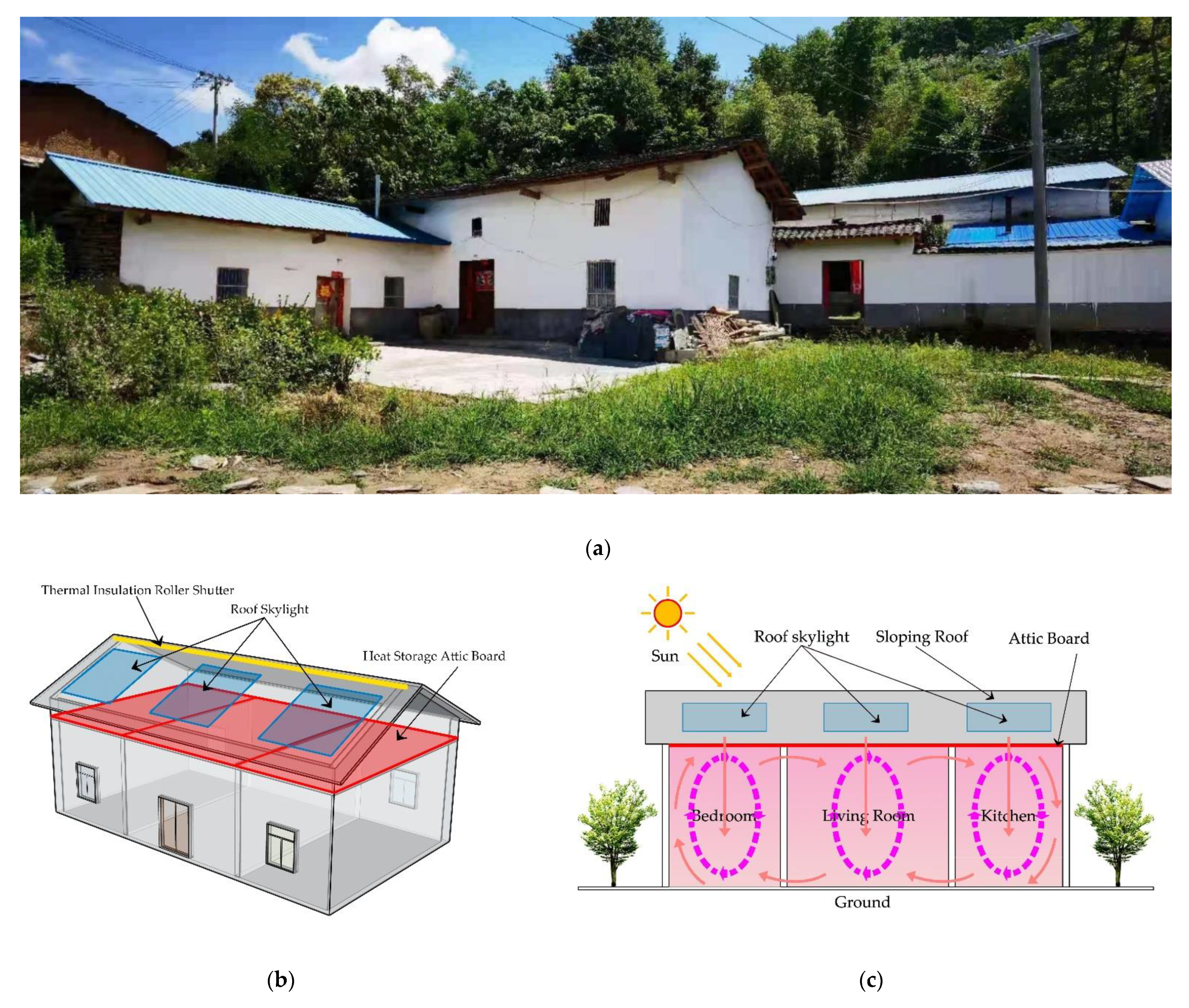
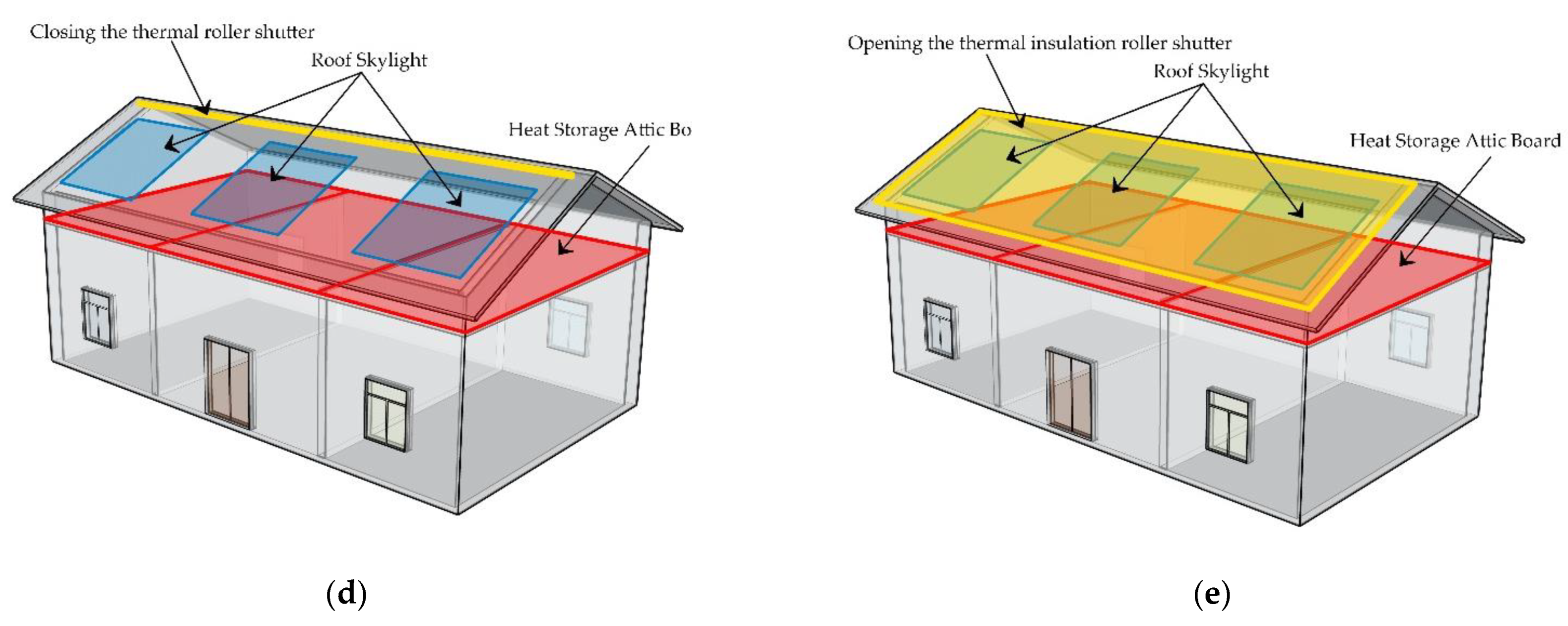
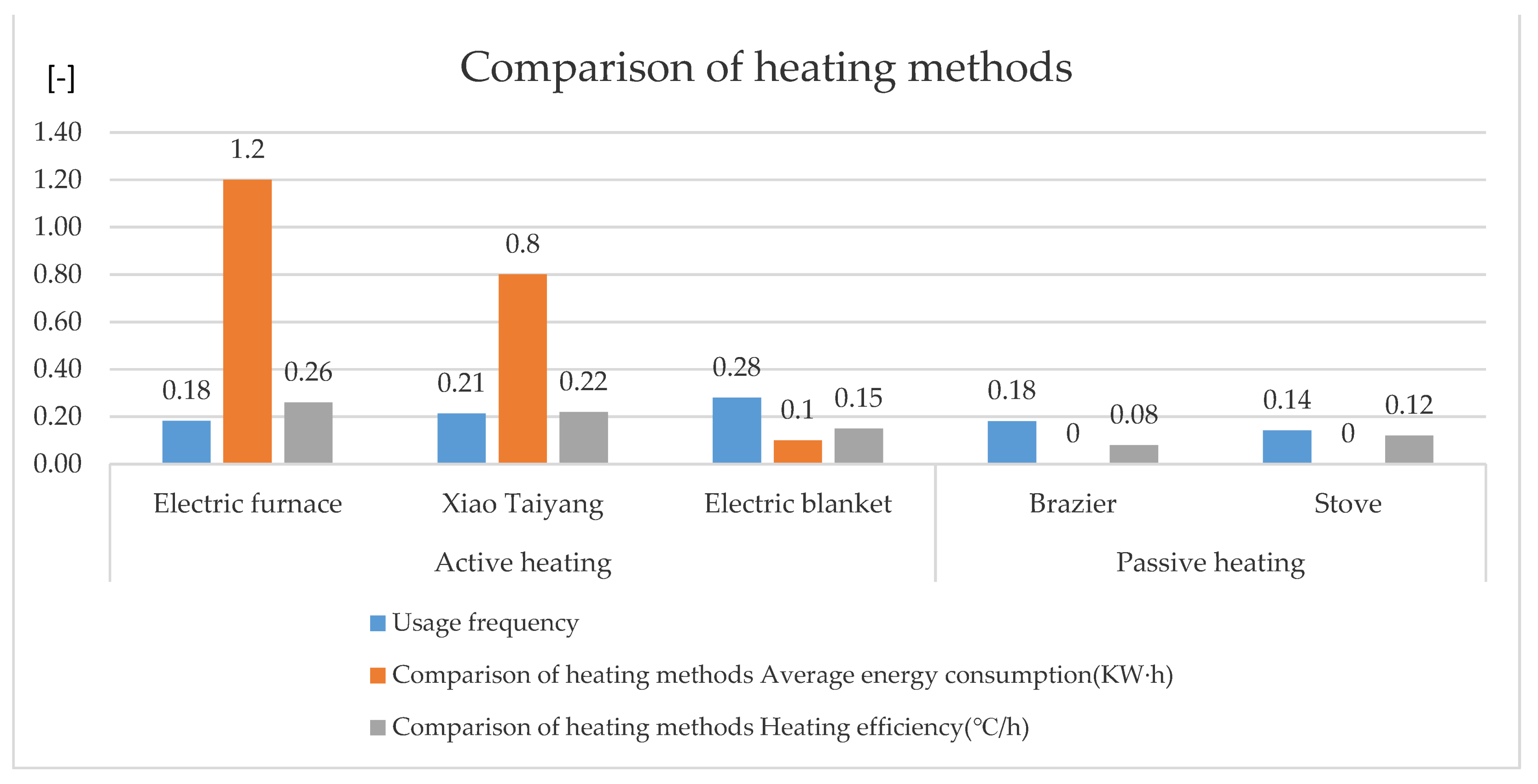
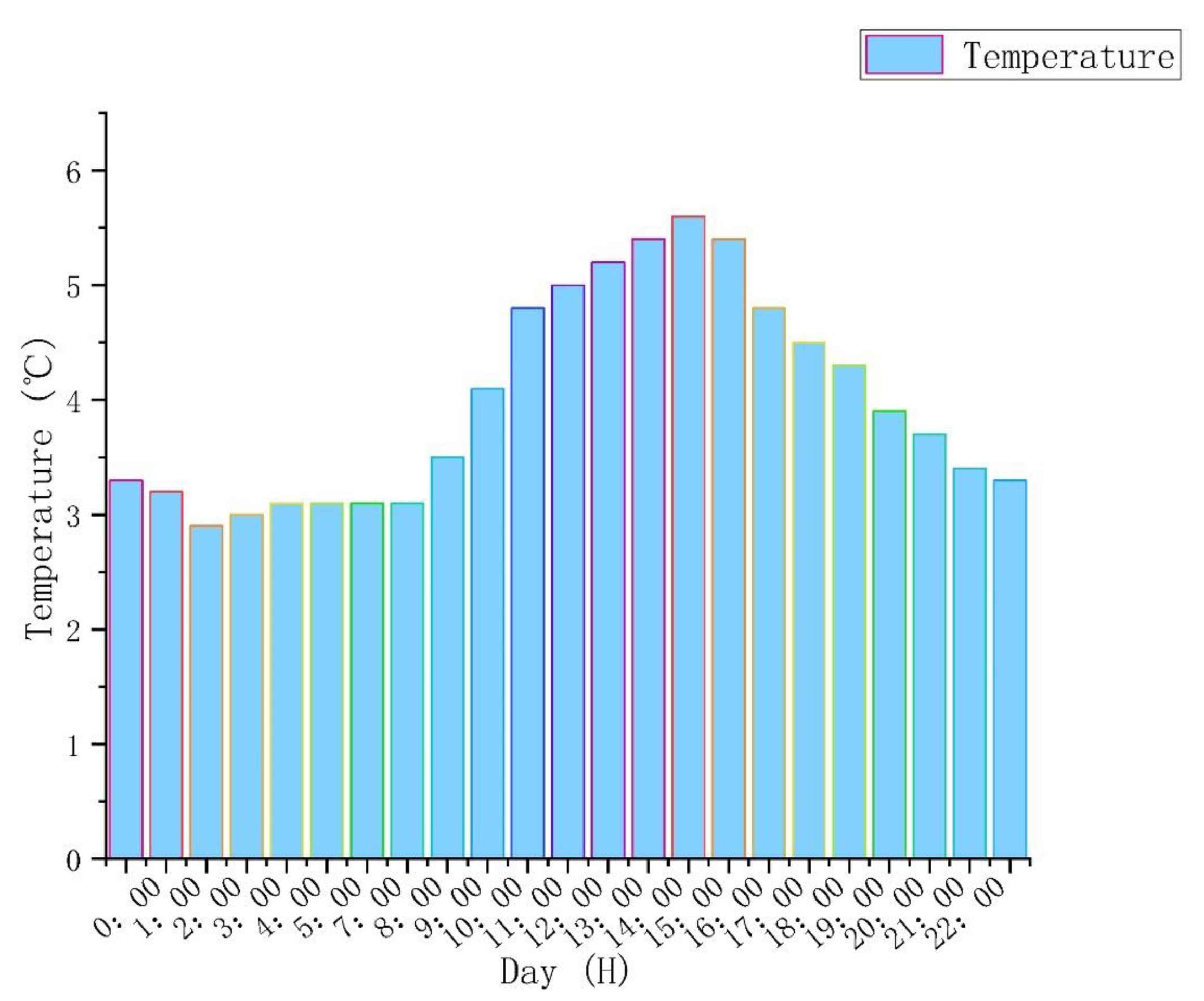
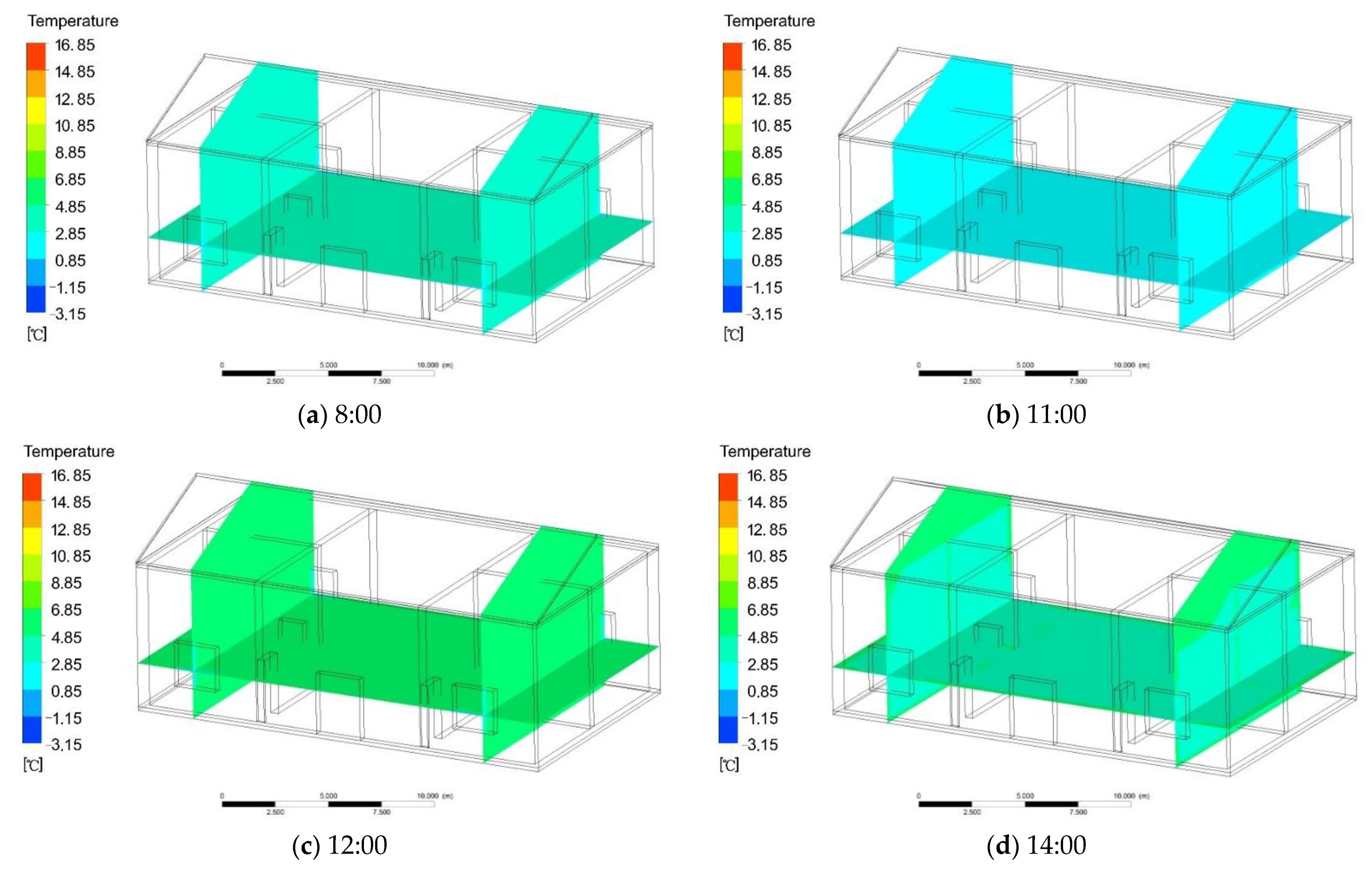
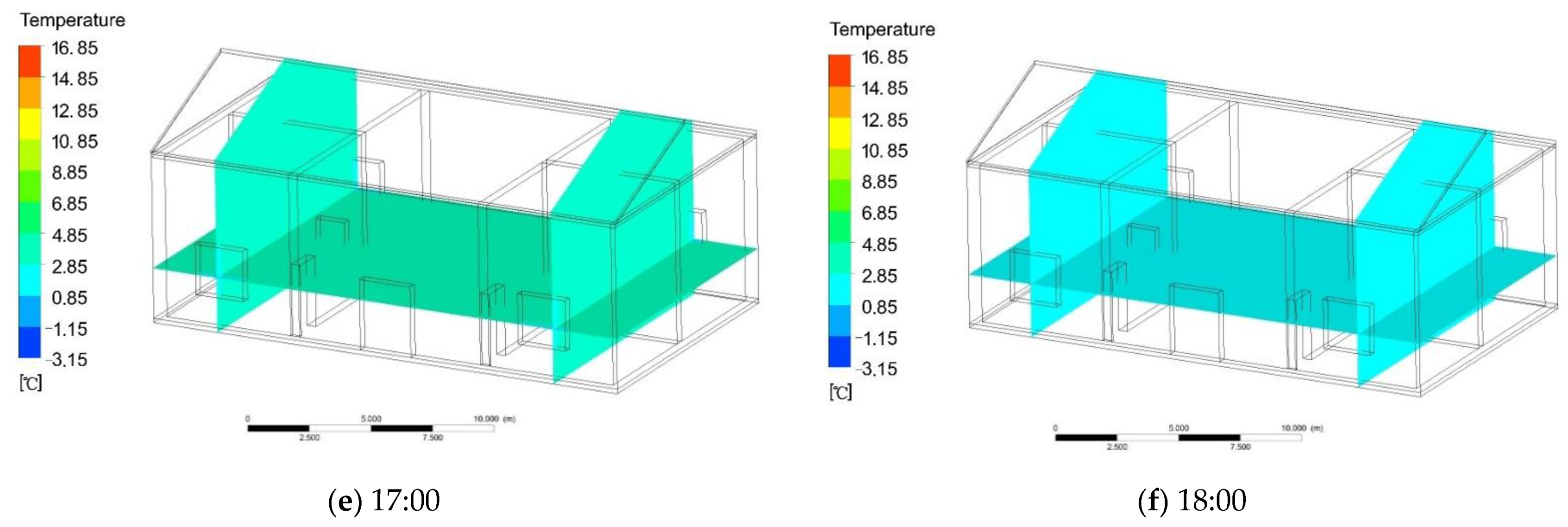

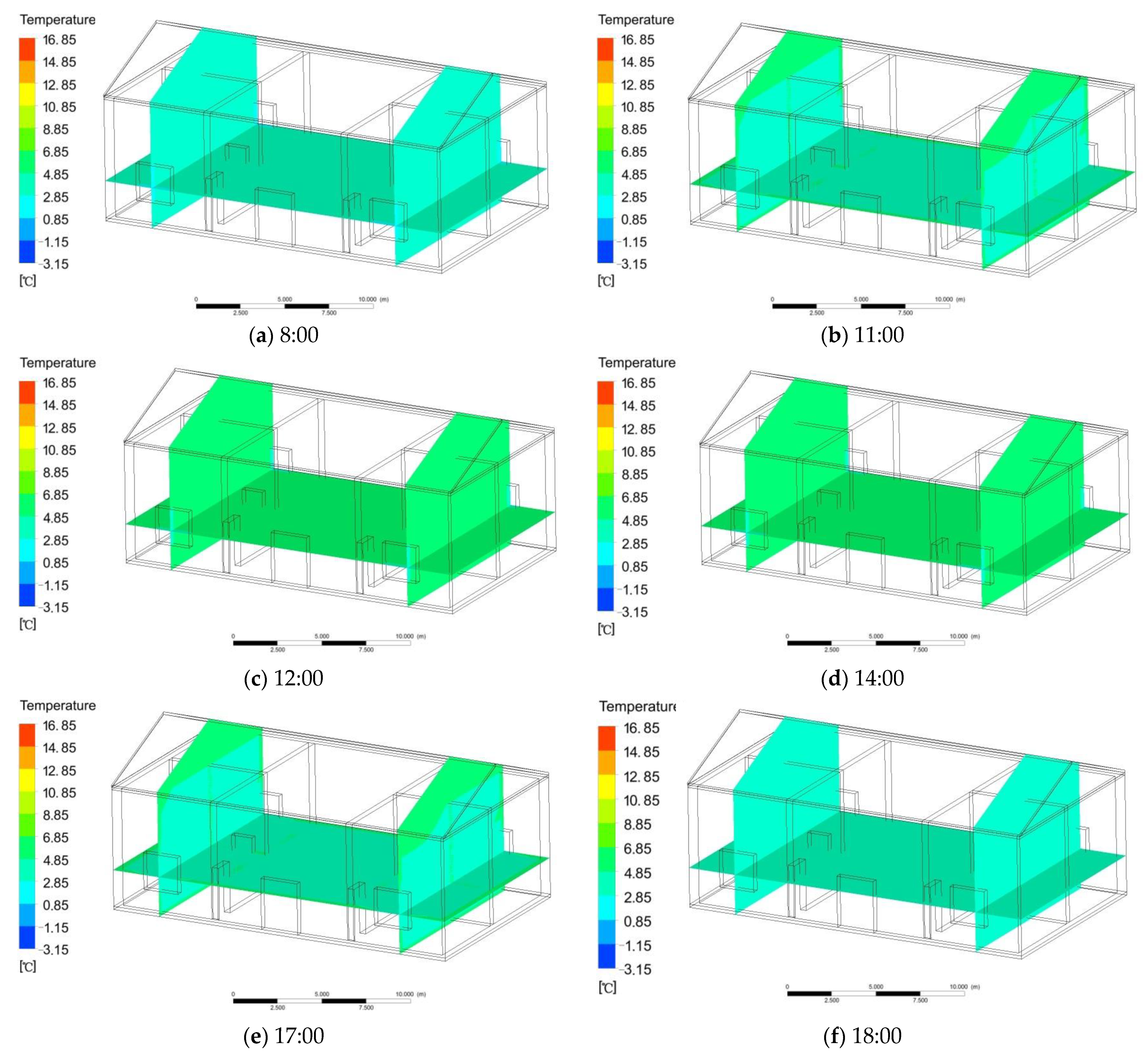
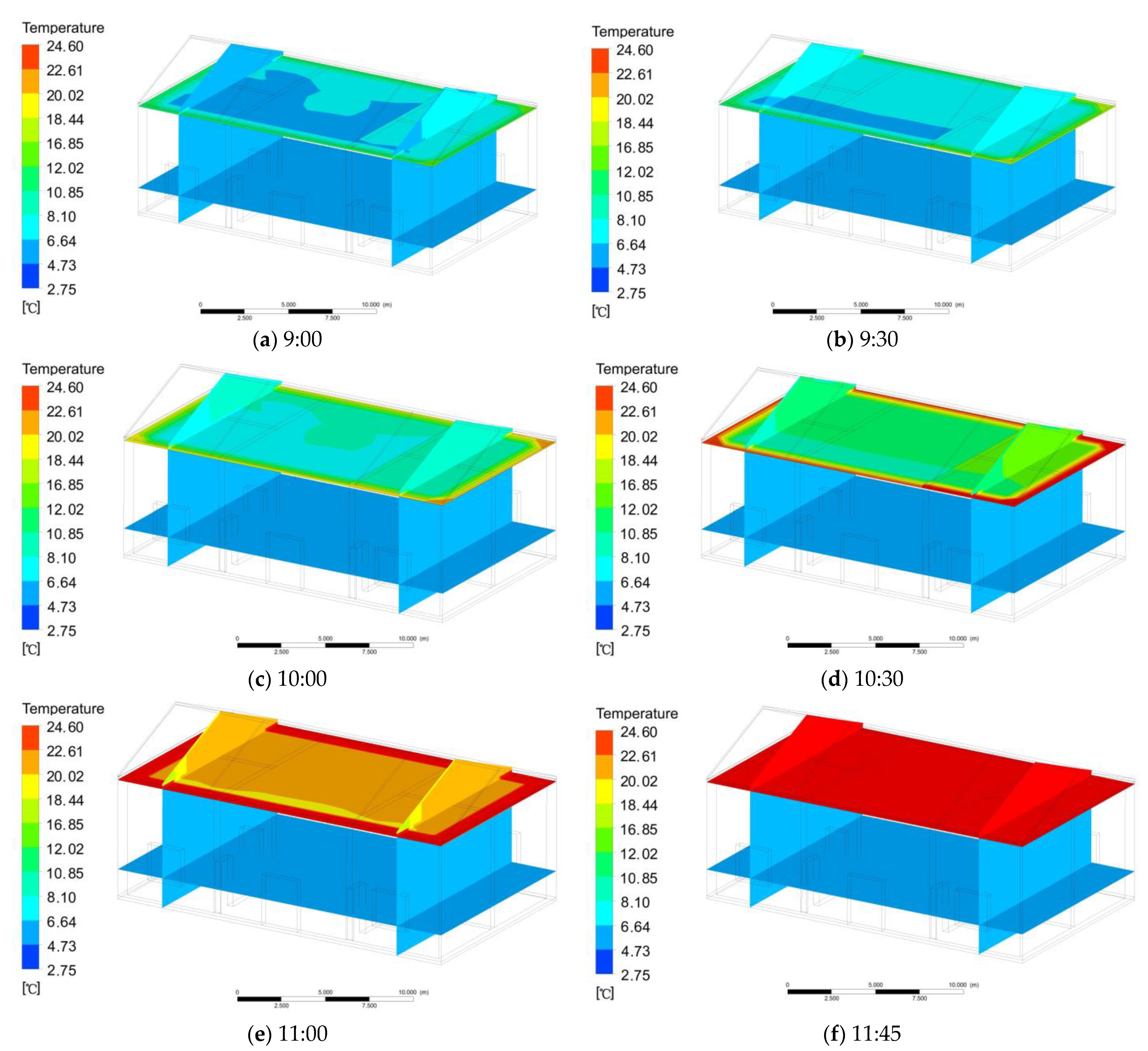
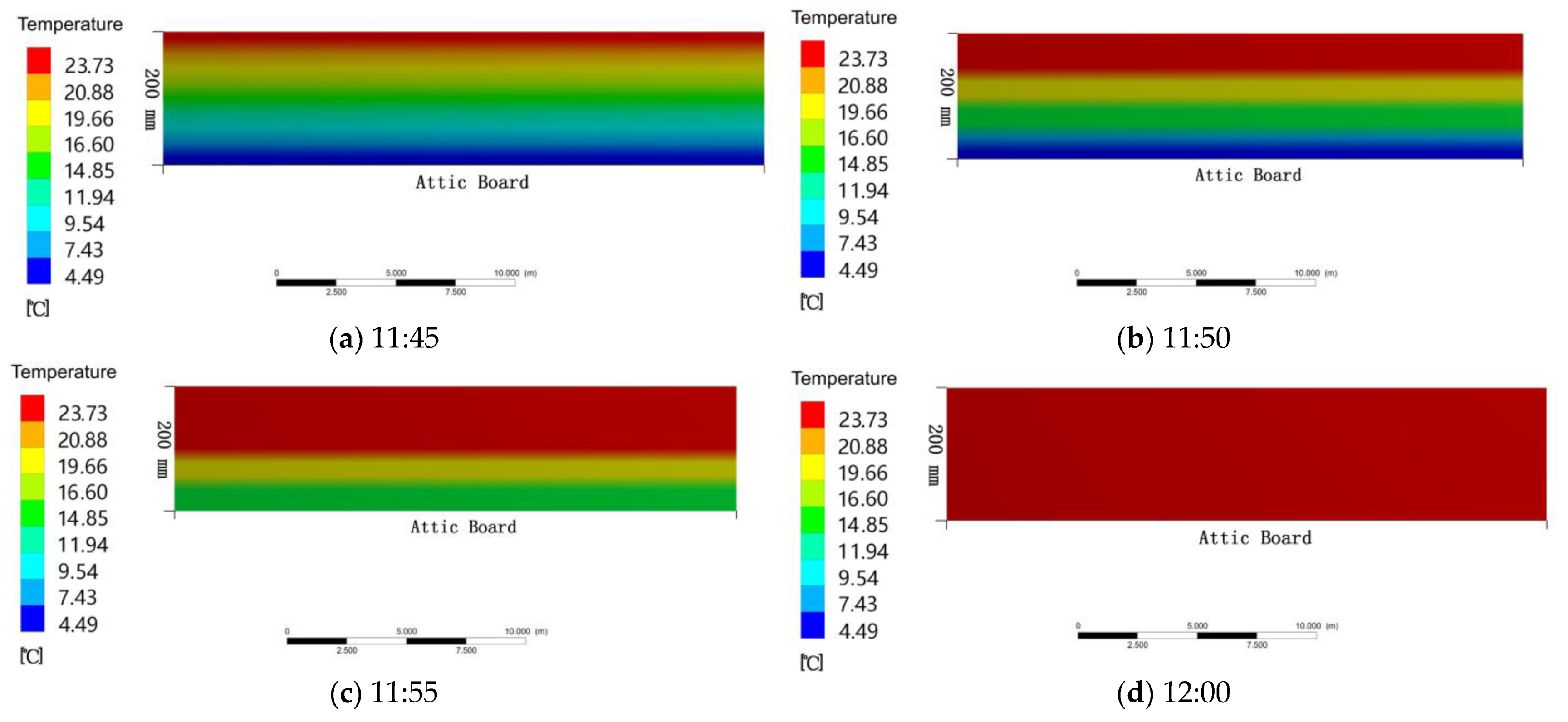
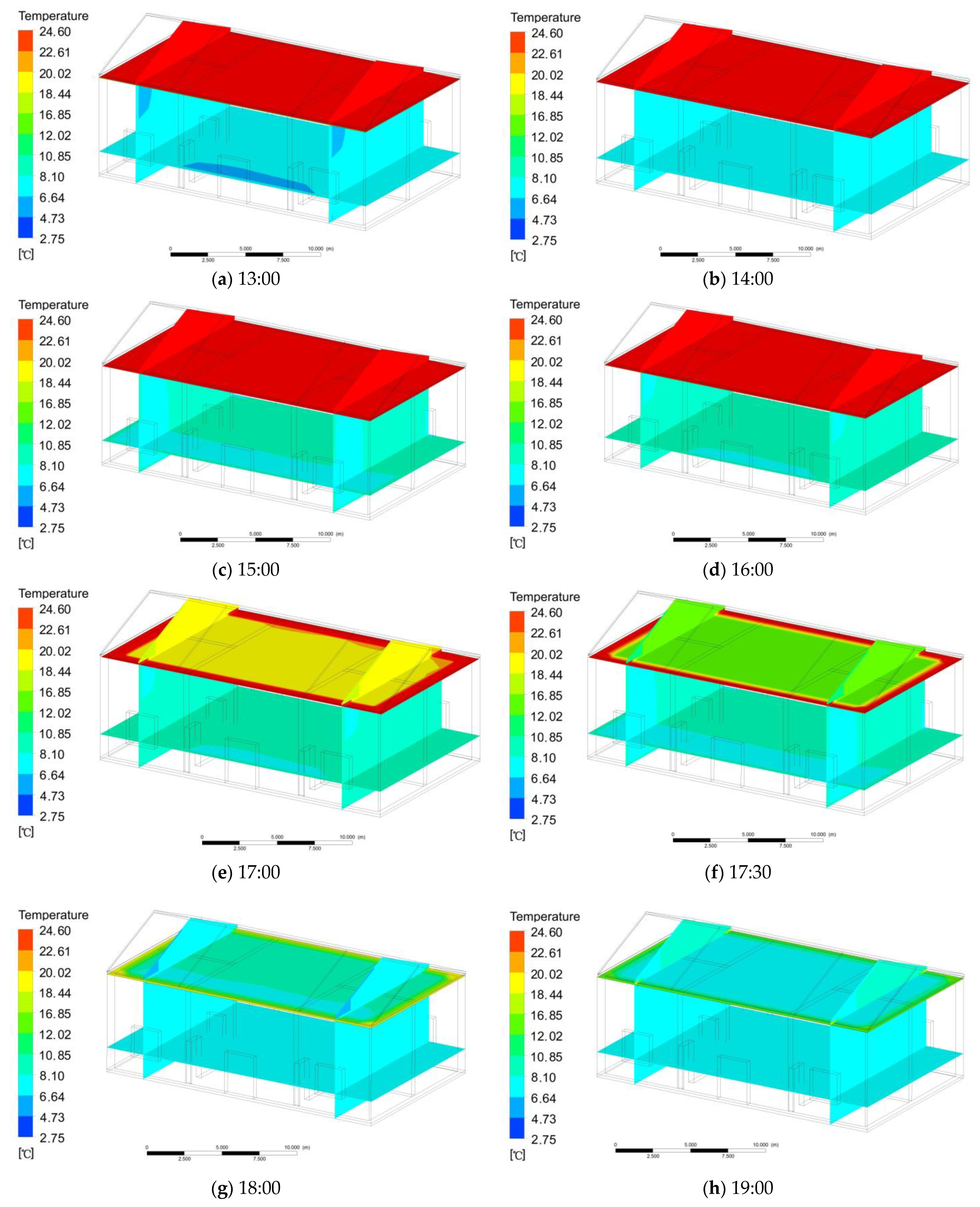
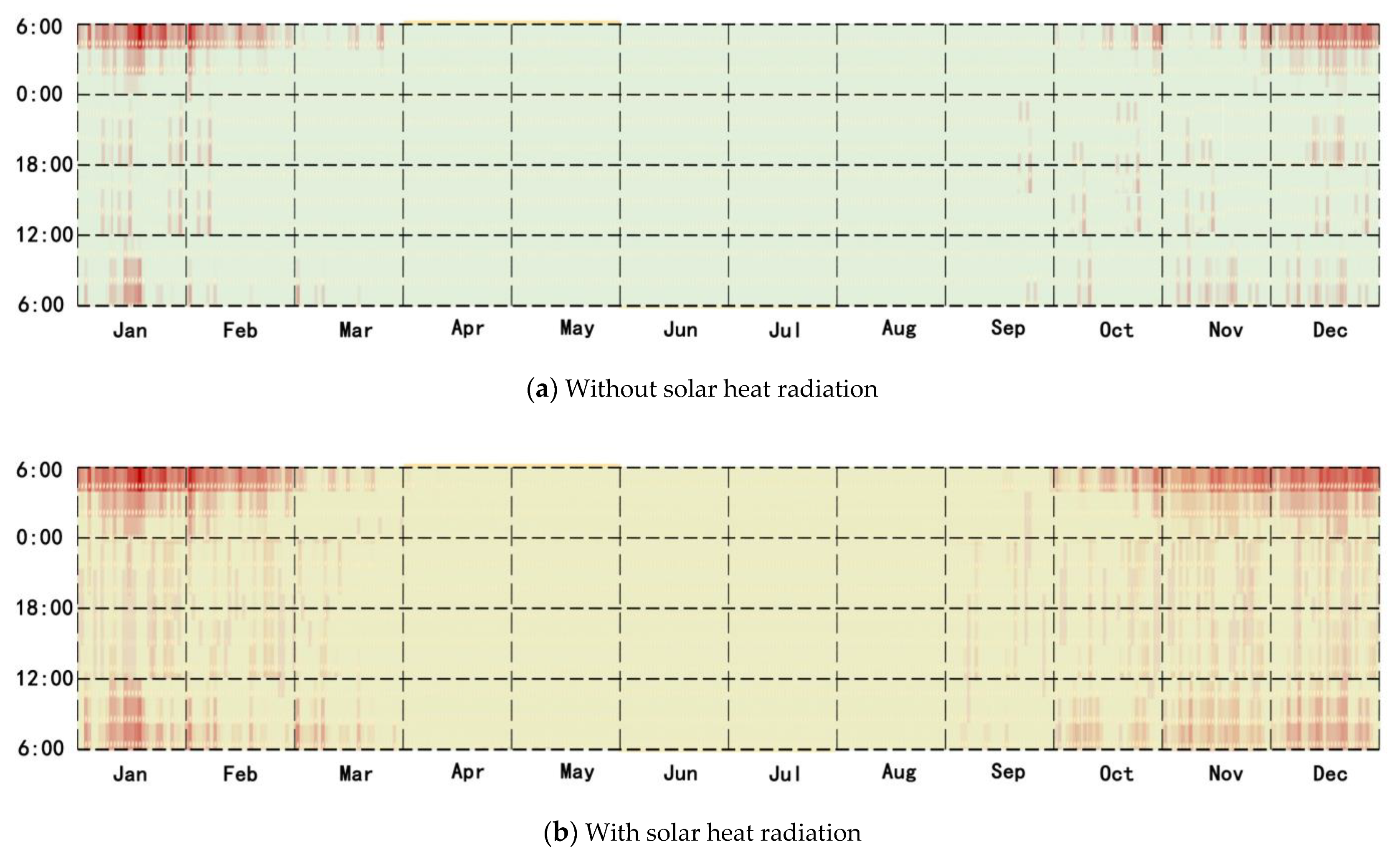


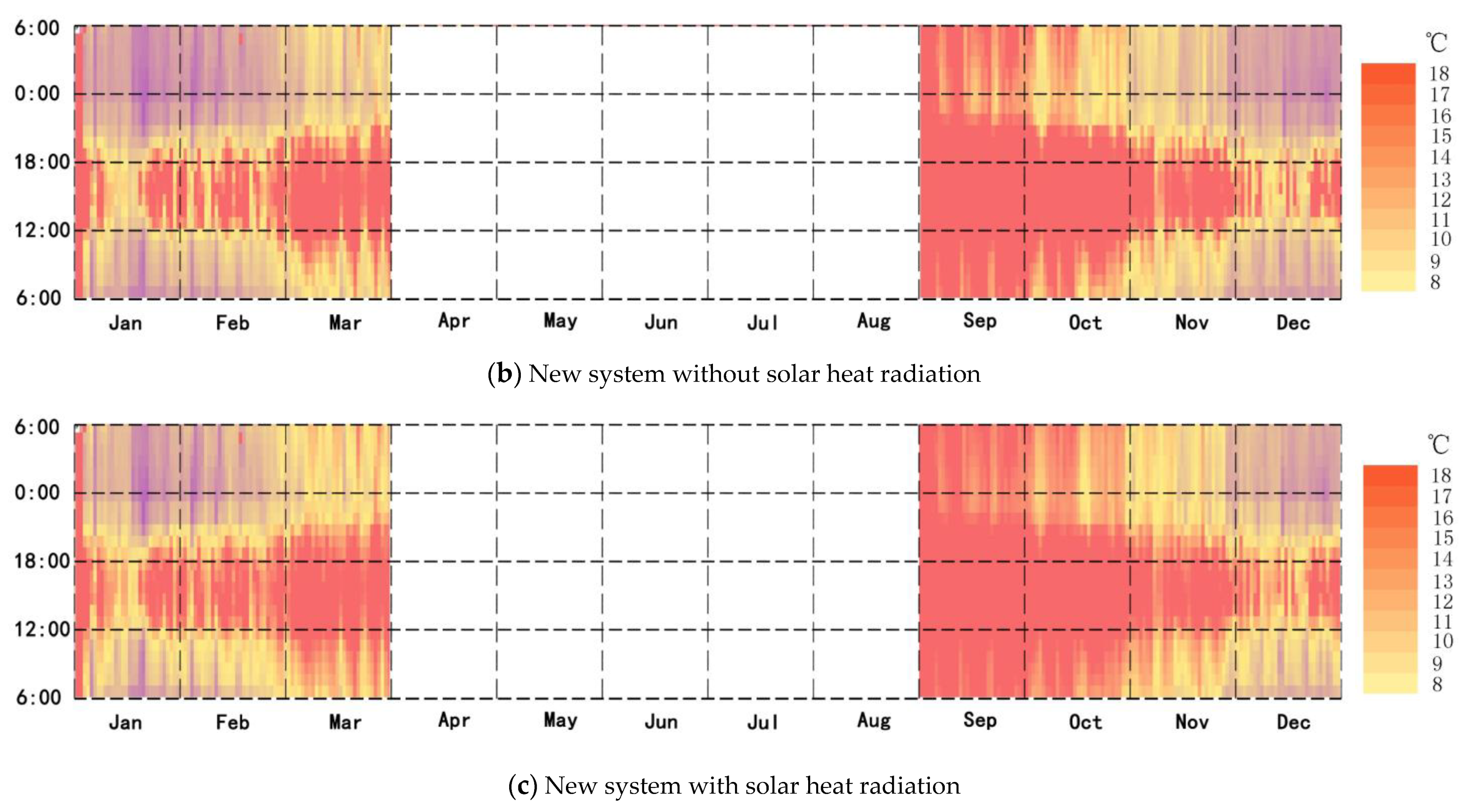
| Material | Melting Temperature (°C) | Heat of Fusion (kJ/kg) |
|---|---|---|
| HDPE | 120–135 | 300 |
| MgCl2·6H2O | 117 | 168.6 |
| Paraffin wax | 64 | 173.6 |
| Polyglycol E6000 | 66 | 190 |
| Biphenyl | 71 | 119.2 |
| Naphthalene | 80 | 147.7 |
| Palmitic acid | 64 | 185.4 |
| Stearic acid | 69 | 202.5 |
| DAY | Indoor Temperature with Closed Heat Shield (°C) | Indoor Temperature with Open Heat Shield (°C) |
|---|---|---|
| 1 | 5.9 | 3.7 |
| 2 | 6.3 | 3.9 |
| 2 | 5.9 | 3.6 |
| 3 | 6.4 | 3.6 |
| 4 | 6.3 | 3.9 |
| 5 | 6.2 | 3.9 |
| 6 | 6.5 | 3.8 |
| 7 | 5.9 | 4 |
| 8 | 6.3 | 3.7 |
| 9 | 6.3 | 3.9 |
| 10 | 5.9 | 3.7 |
| Average temperature | 6.2 | 2.8 |
Publisher’s Note: MDPI stays neutral with regard to jurisdictional claims in published maps and institutional affiliations. |
© 2021 by the authors. Licensee MDPI, Basel, Switzerland. This article is an open access article distributed under the terms and conditions of the Creative Commons Attribution (CC BY) license (https://creativecommons.org/licenses/by/4.0/).
Share and Cite
Chen, S.; Dewancker, B.J.; Yang, S.; Mao, J.; Chen, J. Study on the Roof Solar Heating Storage System of Traditional Residences in Southern Shaanxi, China. Int. J. Environ. Res. Public Health 2021, 18, 12600. https://doi.org/10.3390/ijerph182312600
Chen S, Dewancker BJ, Yang S, Mao J, Chen J. Study on the Roof Solar Heating Storage System of Traditional Residences in Southern Shaanxi, China. International Journal of Environmental Research and Public Health. 2021; 18(23):12600. https://doi.org/10.3390/ijerph182312600
Chicago/Turabian StyleChen, Shuo, Bart J. Dewancker, Simin Yang, Jing Mao, and Jie Chen. 2021. "Study on the Roof Solar Heating Storage System of Traditional Residences in Southern Shaanxi, China" International Journal of Environmental Research and Public Health 18, no. 23: 12600. https://doi.org/10.3390/ijerph182312600
APA StyleChen, S., Dewancker, B. J., Yang, S., Mao, J., & Chen, J. (2021). Study on the Roof Solar Heating Storage System of Traditional Residences in Southern Shaanxi, China. International Journal of Environmental Research and Public Health, 18(23), 12600. https://doi.org/10.3390/ijerph182312600







